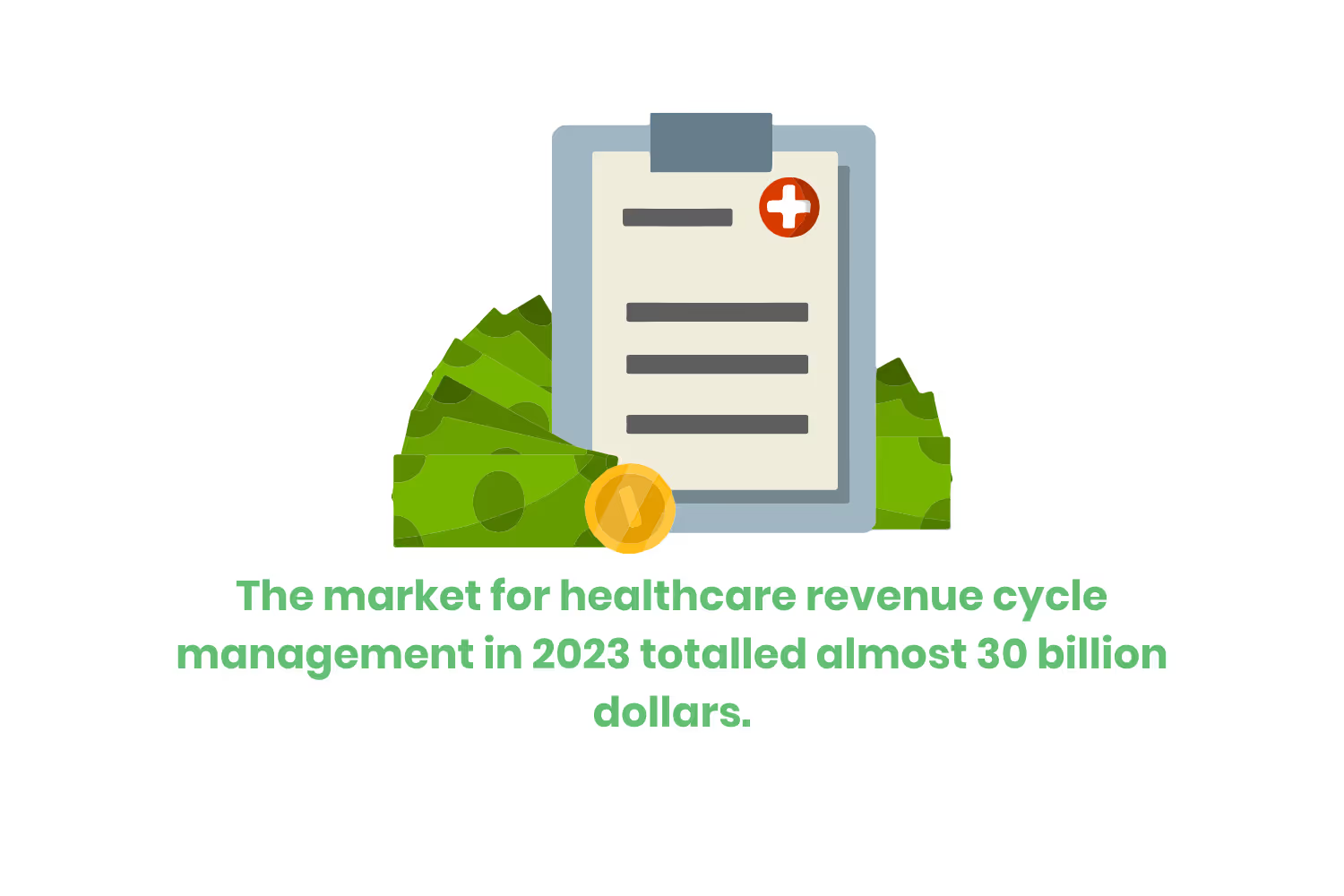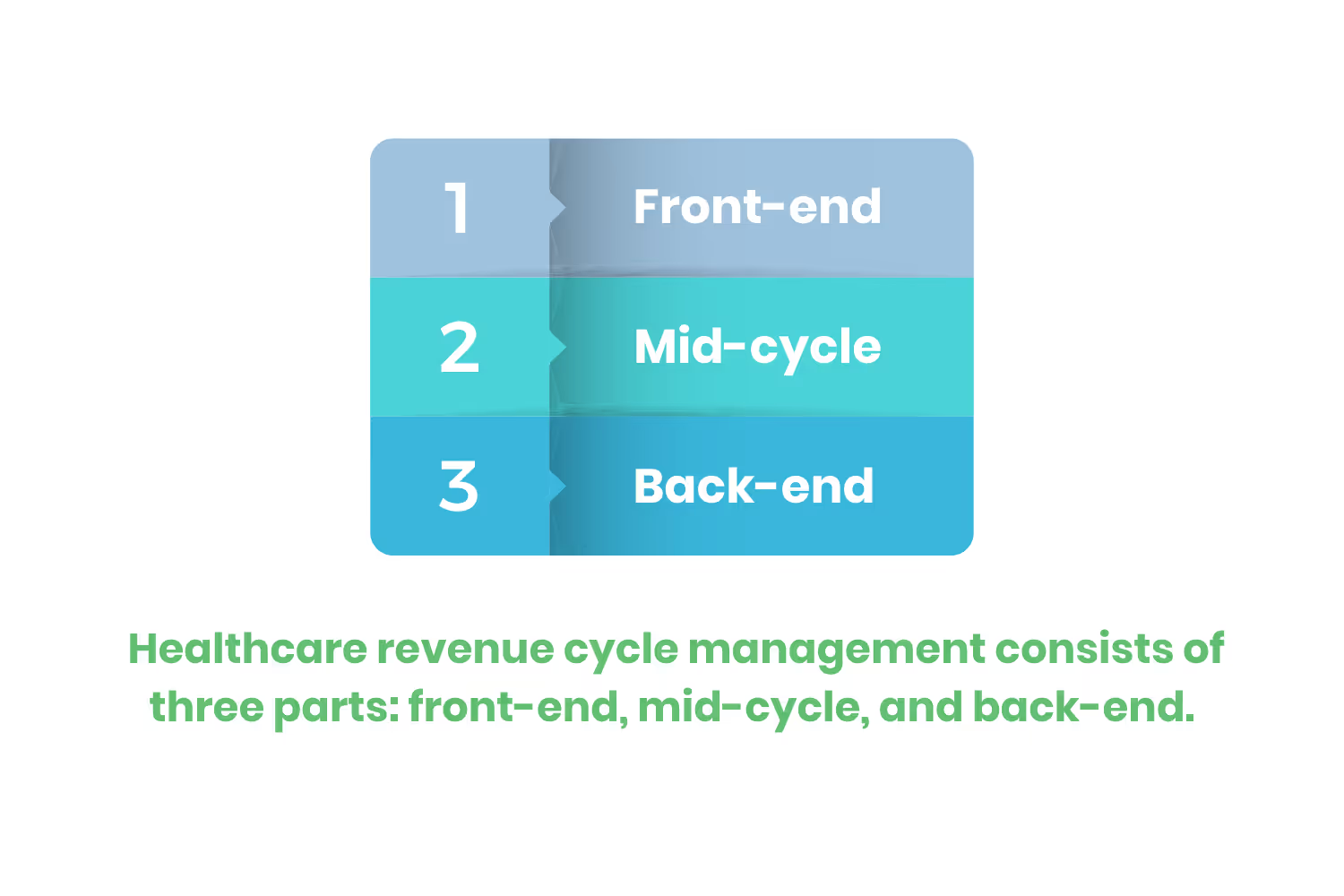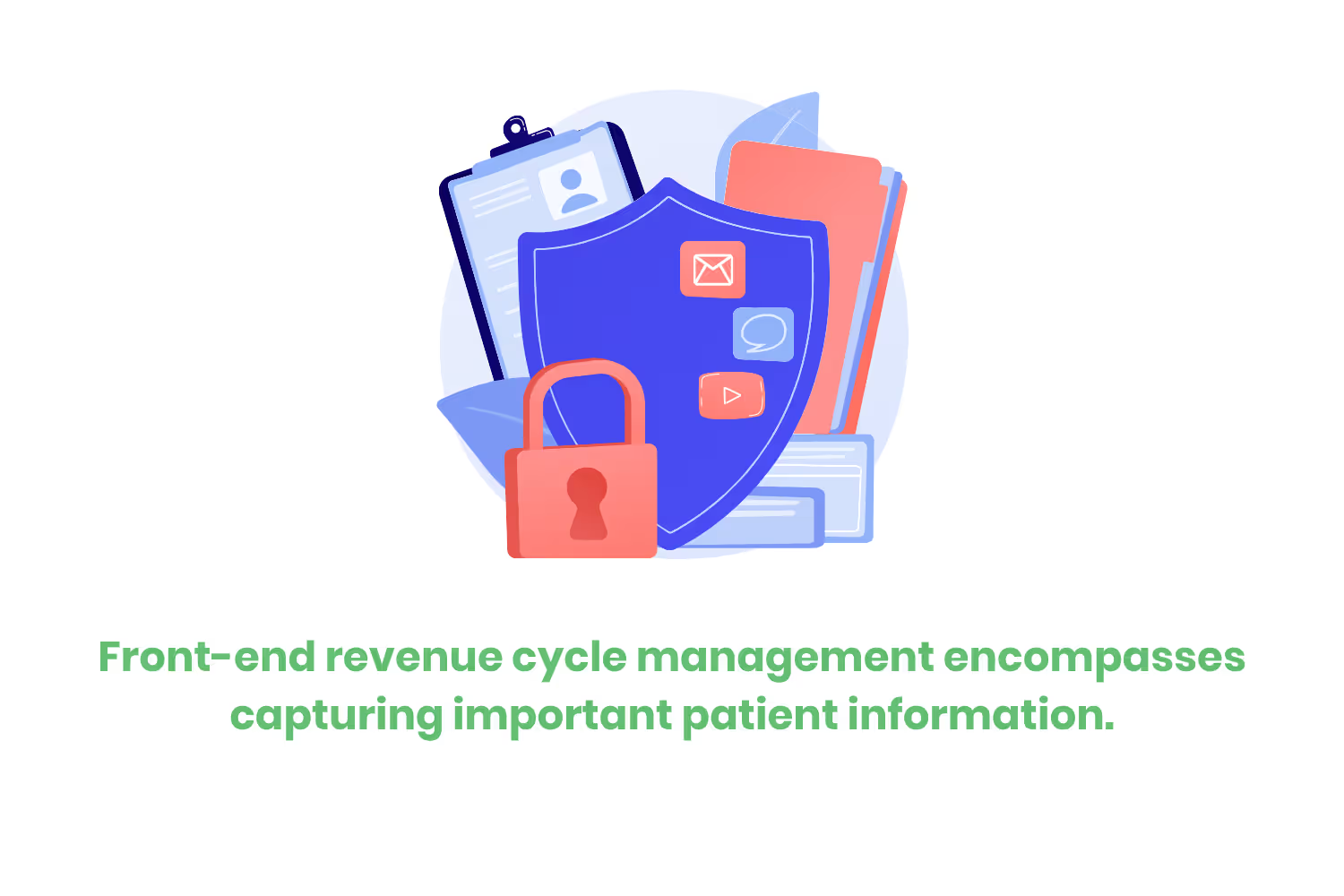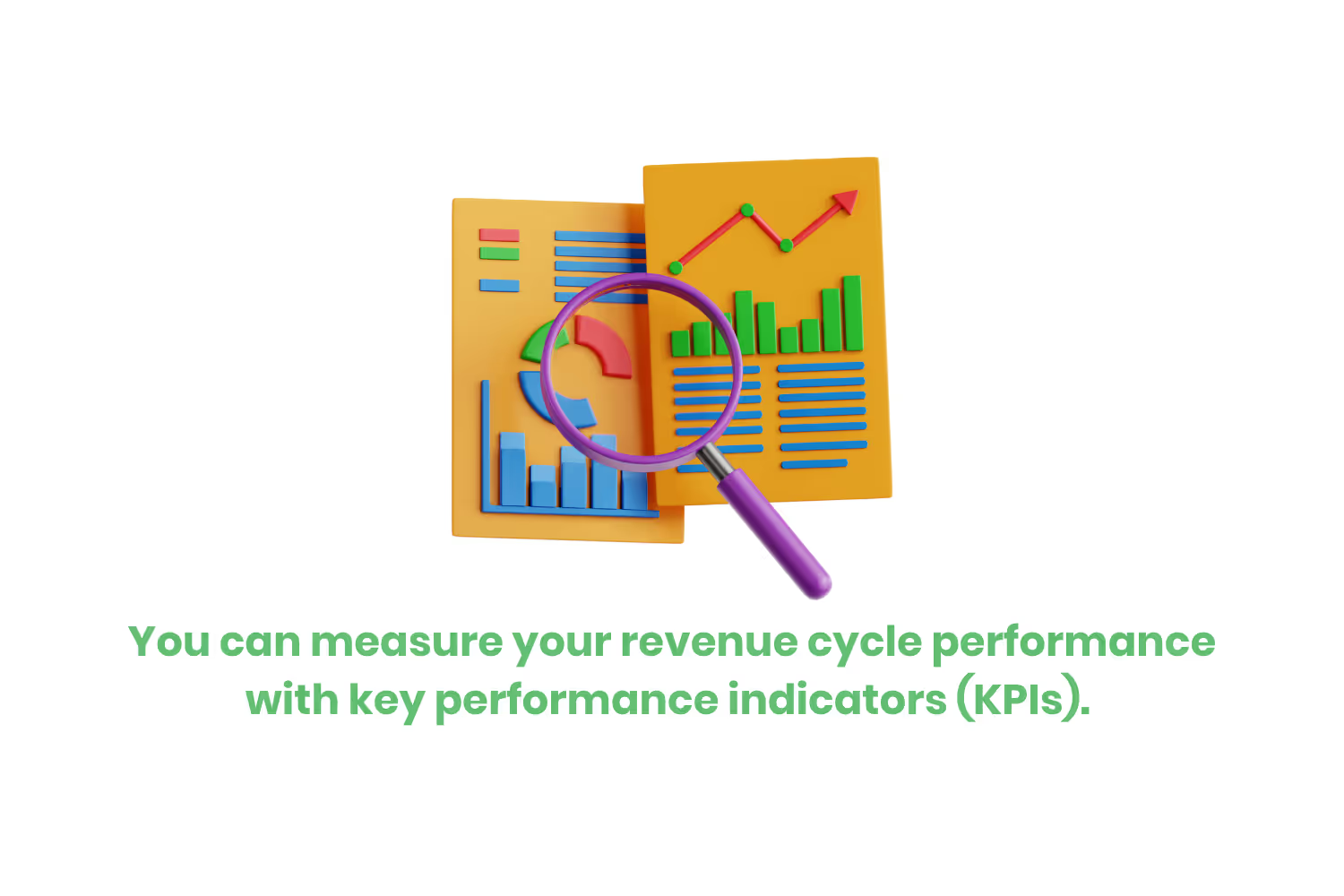Front-End Revenue Cycle Management: Everything You Need to Know
The work before the clinical encounter is just as important as what follows! Let’s take a look at this part of the cycle, the functions it’s made up of, and how it affects revenue cycle efficiency.

The market for healthcare revenue cycle management in 2023 totaled almost 30 billion dollars.
When we talk about healthcare revenue cycle management (RCM), we are referring to a few key aspects. For example, how this system helps with managing both the administrative and clinical functions of healthcare facilities.
This process consists of three different parts. All of which hold different, but equally important roles. These parts are the: front-end, mid-cycle, and back-end. And each of these parts make up even further divided stages.

Every point acts like a gear in a watch. So long as all cogs are turning, there are no worries! However, if any of the gears experience issues it affects the entire cycle.
That’s why it’s important to have eyes on all three parts. Neglecting even one facet of the revenue cycle management system can be detrimental. So much of the focus tends to go to the mid-cycle and back-end stages, where revenue management and claims management ensure that healthcare organizations ultimately get paid. Some examples of these functions are coding and billing. As well as denials management, and payment posting.
But what about the front-end services?
The work before the clinical encounter is just as important as what follows, as it directly affects patient experience and timely revenue collection. Let’s take a look at this part of the cycle, the functions it’s made up of, and how it affects revenue cycle efficiency.
What is Front-End Revenue Cycle Management?
Front-end revenue cycle management encompasses quite a few important processes. All of which involve capturing important patient information. These functions occur at the first point of patient interaction and scheduling.
They then carry on through registration and eligibility verification. Ensuring that these initial processes run smoothly is essential for timely revenue collection.

Key Components of Front-End Revenue Cycle Management
All of which lay the groundwork for a smooth financial workflow:
- Scheduling and Appointments: The process of recording patient appointments. As well as managing the timeframe of the visits. Having proper scheduling and maintaining your providers’ schedules is the name of the game. By booking a patient with the correct provider, you are ensuring that the following services provided are properly billed. This process, thus, can also include referral management.
- Patient Registration: Pretty self-explanatory. You need to collect patient information when scheduling an appointment. Things like demographics, contact information, insurance information and all that. Any necessary authorization or consent forms, too, to ensure compliance. This is an essential piece of the revenue cycle management puzzle! Without accurate patient health information, it is impossible to bill or collect on reimbursement from the payer.
- Insurance Verification: Front-end staff must first verify benefits with the patient’s insurance company. This is how you determine the extent of a patient’s insurance coverage. Healthcare organizations should check this before rendering services. By doing so, you can avoid claim denials as well as other billing issues down the road. Expectations on copayments, deductibles, and coverage limitations are then more transparent. The clearer the communication line, the better.
- Prior Authorization: Some medical procedures or treatments may need something called “prior authorization”. Another front-end process that is crucial when it comes to running a smooth RCM system. This means that your team may need to reach out to a patient’s insurance provider. Do this to get one of these authorizations before rendering any services.
- Financial Counseling: Helping your patients understand their part in the RCM cycle is also important. Insurance coverage, financial help, and payment options can be overwhelming to those working in the healthcare field. Imagine how your patients must feel! Offering insight into cost estimation and coverage can prevent payment surprises. This can reduce the rate of bills sent to collections.
- Copay and Deductibles: Collecting a patient’s part of the healthcare costs before or after the appointment. Getting this taken care of as soon as possible ensures that payments occur. It also prevents possible revenue leakage.
- Charge Capture: This front-end component ensures that all billable items from a patient encounter occur are recorded. Accurate documentation is critical for proper medical coding and medical billing, which ensures correct reimbursement.
- Compliance and Documentation: Making sure to adhere to them by documenting services accurately is key. This is especially true because regulatory requirements are so important. Don’t let this component fall through the cracks when coding procedures! Always double-check to make sure the correct services are being reflected in the billing codes.
The common denominator for each of these components? They all involve the patient. You can also think of front-end services as part of the “patient access” experience. Having open communication with your clients and a way for them to access your services is always a best practice.
Front-End Revenue Cycle Challenges
I mentioned a few challenges that could arise during this phase. The problems that come with front-end tasks can lead to disruptions in your revenue cycle. Inaccurate or incomplete data is the perfect example of this. Always make sure your patient's data is correct during registration. If you don't, it may lead to financial problems down the road. You should also make sure returning patients’ information is still the same. In case they changed healthcare providers and so on.

Another reason for your reimbursement delays is by overly-utilizing manual processes. Having your team complete front-end tasks manually raises the risk of more human error. And quite frankly, it takes more time to complete these processes this way, bogging down your revenue cycle. And quite frankly, it takes more time to complete these processes this way, bogging down your billing process. If errors pile up, it can eventually turn into uncollected balances and bad debt. Luckily, this is where RCM systems come into play. You can lessen the load on your billing team and keep important information safe.
Utilizing Automation in Front-End Revenue Cycle
Having automation on the front end will assist your staff in facing the common challenges they may face.
Patient Intake & Registration
Automation starts as soon as the appointment is scheduled. There are many tools that help with patient intake and registration. This allows patients to walk in and simply wait for their appointment, no extra paperwork in the waiting room required.
Insurance Verification & Eligibility
Insurance verification is one of the most important parts of the check-in process. Automated tools give staff instant confirmation of a patient’s benefits. This cuts down on human error, like missing details or using incorrect information, and helps prevent costly billing mistakes later on. By reducing errors upfront, your organization can process cleaner claims and get paid faster.
Prior Authorization Management
When a patient needs prior authorization for a service, billing staff would have to identify what services require it manually. With the prior authorization management systems, procedures that require approval are automatically flagged. This reduces delays in both care delivery and the reimbursement process.
Patient Communication & Payments
Reminding the patients about payments or missing documents can take up a lot of staff time. Automation systems handle this by sending reminders for upcoming payments or unsigned
Measuring Your Performance
You can measure your revenue cycle performance with key performance indicators (KPIs). This metric allows healthcare organizations to have better insight into their front-end operations. With this tool, you can adjust your processes as needed for continuous optimization of front-end operations. Which in turn enhances your productivity and financial health. KPIs provide tools for spotting issues in your revenue cycle. They provide quick solutions to RCM problems such as delayed claims and reimbursement.
The Healthcare Financial Management Association (HFMA) developed several KPIs to track front-end performance. HFMA MAP Keys establish a standard for healthcare providers to adhere to. This standard holds organizations accountable for achieving and maintaining revenue cycle excellence. This metric draws data from different financial and RCM reports.

These KPIs for front-end revenue cycle processes include:
- Percentage of patient schedule occupied.
- Pre-registration rate.
- Insurance verification rate.
- Service authorization rate (inpatient and/or observation).
- Service authorization rate (outpatient encounters).
- Conversion rate of uninsured patients to third-party funding sources.
- Point-of-service cash collections.
These KPIs help organizations optimize their front-end processes. They also ensure that their revenue cycle remains fluid. The financial health of your organization relies on you being aware of any front-end areas that may need improvement. So take advantage of these valuable insights!
How Does Front-End Revenue Cycle Affect Financial Success?
For healthcare organizations, front end processes are more than just administrative tasks, they are the foundation of overall financial success. Strong management at this stage minimizes denials, speeds us cash flow, and cuts unnecessary costs, directly impacting the bottom line.
Clean Claim Rate
Accurate patient registration and insurance eligibility checks help prevent denied or delayed claims. Each denial can be expensive, and adds onto administrative work,increases costs, and slows the reimbursement process. Having a clean claim is essential for the organization's financial health.
Cash Flow Acceleration
Collecting copays and deductibles upfront ensures revenue is received before services are rendered. Automation tools can submit these requests for payment immediately, reducing any risk of outstanding balances turning into collections.
How to Improve Your Front-End Performance
We spoke about issues in the front-end processes of the revenue cycle. And how they can trickle down to affect your financial health later on. So prioritizing this stage of your revenue cycle is important! Let’s go over a few ways you can avoid these problems. Saving your team from having to spend time and resources fixing avoidable mistakes.
First, reduce the likelihood of human error. Educate your staff on how to communicate with patients. And how to discuss different payment options. As well as how to understand insurance policies. This communication makes it possible for your team to gather accurate billing information. This education should happen with ongoing training and hands-on workshops when possible.

Invest in automating your front-end revenue cycle processes. This further supplements continued education when it comes to reducing human error. Missing information during patient intake is one of the most common front-end mistakes. Consider introducing tools such as digital pre-registration. This reduces manual data entry efforts. All while encouraging patients to complete and verify their information. Patient portals that house tools like this can enhance patient engagement and improve patient satisfaction, while also streamlining front-end workflows. Such as online appointment scheduling and digital payment options. More handy features to help streamline your front-end workflow!
Conclusion
When it comes to accurate and prompt revenue collection, focusing on your front-end RCM strategy is crucial. Being able to understand what constitutes the front-end of healthcare is a good place to start. Being able to efficiently execute services will help you streamline your team’s administrative work relating directly to your revenue cycle.
Track your efficiency and utilize KPIs to further minimize billing errors and data bottlenecks. Leveraging technology to your advantage helps your team stay on top of their daily goals. An overwhelmed employee is usually an unhappy employee.
Consider this as a way to not only better streamline your workflow, but to reduce employee turnover as well. How your front-end works impacts not only your employees but your patients as well. Having a smooth revenue cycle makes navigating the healthcare system easier for your patients. This means better financial health for your business.
Emphasize your product's unique features or benefits to differentiate it from competitors
In nec dictum adipiscing pharetra enim etiam scelerisque dolor purus ipsum egestas cursus vulputate arcu egestas ut eu sed mollis consectetur mattis pharetra curabitur et maecenas in mattis fames consectetur ipsum quis risus mauris aliquam ornare nisl purus at ipsum nulla accumsan consectetur vestibulum suspendisse aliquam condimentum scelerisque lacinia pellentesque vestibulum condimentum turpis ligula pharetra dictum sapien facilisis sapien at sagittis et cursus congue.
- Pharetra curabitur et maecenas in mattis fames consectetur ipsum quis risus.
- Justo urna nisi auctor consequat consectetur dolor lectus blandit.
- Eget egestas volutpat lacinia vestibulum vitae mattis hendrerit.
- Ornare elit odio tellus orci bibendum dictum id sem congue enim amet diam.
Incorporate statistics or specific numbers to highlight the effectiveness or popularity of your offering
Convallis pellentesque ullamcorper sapien sed tristique fermentum proin amet quam tincidunt feugiat vitae neque quisque odio ut pellentesque ac mauris eget lectus. Pretium arcu turpis lacus sapien sit at eu sapien duis magna nunc nibh nam non ut nibh ultrices ultrices elementum egestas enim nisl sed cursus pellentesque sit dignissim enim euismod sit et convallis sed pelis viverra quam at nisl sit pharetra enim nisl nec vestibulum posuere in volutpat sed blandit neque risus.

Use time-sensitive language to encourage immediate action, such as "Limited Time Offer
Feugiat vitae neque quisque odio ut pellentesque ac mauris eget lectus. Pretium arcu turpis lacus sapien sit at eu sapien duis magna nunc nibh nam non ut nibh ultrices ultrices elementum egestas enim nisl sed cursus pellentesque sit dignissim enim euismod sit et convallis sed pelis viverra quam at nisl sit pharetra enim nisl nec vestibulum posuere in volutpat sed blandit neque risus.
- Pharetra curabitur et maecenas in mattis fames consectetur ipsum quis risus.
- Justo urna nisi auctor consequat consectetur dolor lectus blandit.
- Eget egestas volutpat lacinia vestibulum vitae mattis hendrerit.
- Ornare elit odio tellus orci bibendum dictum id sem congue enim amet diam.
Address customer pain points directly by showing how your product solves their problems
Feugiat vitae neque quisque odio ut pellentesque ac mauris eget lectus. Pretium arcu turpis lacus sapien sit at eu sapien duis magna nunc nibh nam non ut nibh ultrices ultrices elementum egestas enim nisl sed cursus pellentesque sit dignissim enim euismod sit et convallis sed pelis viverra quam at nisl sit pharetra enim nisl nec vestibulum posuere in volutpat sed blandit neque risus.
Vel etiam vel amet aenean eget in habitasse nunc duis tellus sem turpis risus aliquam ac volutpat tellus eu faucibus ullamcorper.
Tailor titles to your ideal customer segment using phrases like "Designed for Busy Professionals
Sed pretium id nibh id sit felis vitae volutpat volutpat adipiscing at sodales neque lectus mi phasellus commodo at elit suspendisse ornare faucibus lectus purus viverra in nec aliquet commodo et sed sed nisi tempor mi pellentesque arcu viverra pretium duis enim vulputate dignissim etiam ultrices vitae neque urna proin nibh diam turpis augue lacus.



![[ANSWERED] What is a Long-Term Care (LTC) Pharmacy](https://cdn.prod.website-files.com/67e2b8210878abcba6f91ae6/68d687806a075a1cf64659b0_WhatisLongTermCarePharmacy_925.avif)
